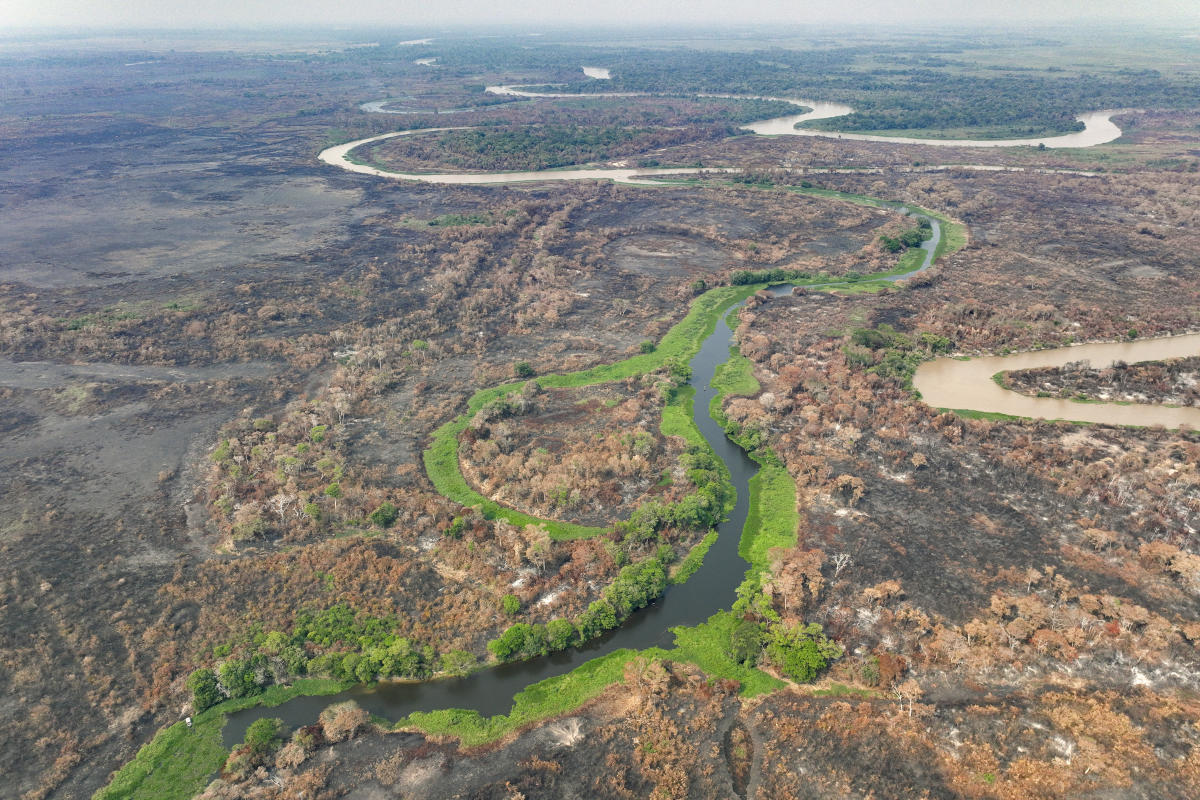SAO PAULO (AP) — Brazil’s vast Pantanal wetlands haven’t technically started their annual fire season yet, but the number of fires is already breaking records and experts predict this year will be the most destructive in decades.
Normally, the world’s largest tropical wetlands dry out and are prone to fires from July to September. But the National Space Research Institute’s satellites detected more than 2,500 fires in the region in June alone – by far the highest number ever recorded for the month in data going back to 1998. It’s more than six times as many as in the same month of 2020, known as the “year of flames”, when wildfires ravaged the area and caused widespread outrage.
“We are facing one of the worst situations ever in the Pantanal,” Environment Minister said Marina Silva told journalists on Monday that the entire Paraguay River basin is facing serious water shortages.
Fed by tributaries of the Paraguay River and located largely in Brazil, the Pantanal is a biodiversity hotspot and a popular destination for tourists hoping to see jaguars, macaws, caimans, capybaras and migratory birds in the wild.
But now, instead of the charming natural scenes, Brazilians see devastating fires from the Pantanal that devour flora and charred animals.
On Friday, Silva flew to Corumba, one of the hardest-hit cities, with Planning and Budget Minister Simone Tebet, who was born in the region and built her political career there. Both described what they saw as painful.
“It was a river that was winding like a wall, trying to hold back the fire,” Silva said. “Amid so many ashes, a tree blossomed, in gratitude for life. We cannot destroy it.”
The environment minister attributed the fires to human activity, climate change and long-term impacts of El Nino and La Nina phenomena that are altering sea surface temperatures in the central and eastern Pacific Ocean.
The Brazilian federal government has deployed 285 police officers from various agencies and 82 members of the National Guard to support local fire departments.
Following 2020’s record fires, which burned nearly 30% of Brazil’s Pantanal, local authorities expanded their fire committees to include several government departments and environmental nonprofits, such as the World Wildlife Fund and SOS Pantanal. The committees discuss fire management and monitoring and train local communities in fire prevention and early response.
They are already struggling to contain the current fires. Manuel Garcia da Silva, head of a fire department, says his biggest problem is the distance between them and the terrain, which ranges from savannah to wetlands.
“Most fires in the Pantanal take place underground. We can’t see them, but around 10 a.m. they surface again,” he told The Associated Press. “They continue to burn underground because of the material deposited by the Pantanal floods. These fires are very difficult to control because they burn through almost a meter of material underground.”
Garcia da Silva said his brigade spends seven hours a day fighting fires, often two days in a row. “As long as we have strength, we will keep fighting,” he added.
Conditions in the Pantanal are currently more severe than in 2020. Expectations of extreme drought in August and September are causing additional unrest.
“It could worsen the fire situation,” said Vinicius Silgueiro, coordinator of the territorial intelligence service of the Center for Life Institute in Mato Grosso state.
During the rainy season, rivers overflow their banks, flooding the land and making most of it accessible only by boat and plane. This year, the Paraguay River basin saw a significant deficit in rainfall since the rainy season began in October.
In June, all but one of the region’s 12-meter-deep rivers were below average for this time of year, according to a June 26 bulletin from the Geological Survey of Brazil. The agency warned in February that 2024 could be one of Brazil’s driest years on record.
“The current situation is extremely worrying. Prolonged drought and high temperatures are putting pressure on vegetation, making it susceptible to burning,” said Renata Libonati, professor of meteorology and coordinator of the Federal University of Rio de Janeiro’s warning system for fires in the Pantanal. According to its monitoring system, fires have destroyed more than 688,000 hectares (1.7 million acres) of the Brazilian part of the biome since January.
According to Libonati, most of the ongoing fires are most likely man-made and not natural causes such as lightning. Minister Silva said earlier this week that 85% of the fires started in private properties.
Traditional farmers in the region use fire to manage and renew grazing areas, although the practice is prohibited during the dry season. The ban usually takes effect on July 1, but authorities moved the date to early June this year due to dry conditions.
Silva sounded the alarm about the looming danger of Pantanal fires during a ceremony on World Environment Day on June 5. Environmental organizations active in the region had been warning about the danger for a long time.
“In 2020, it was said that the next four years would be very dry and that water levels in the Pantanal would not recover,” Osvaldo Barassi Gajardo, a conservation specialist at the World Wildlife Fund, said by phone.
A recent study by Brazil’s Space Institute found that arid and semi-arid areas have expanded across the country over the past 30 years. Proportionally, the Pantanal was the Brazilian biome that has dried up the most since 1985, according to a study published earlier this week by MapBiomas, a research initiative that maps land use. In the coming decades, the center-west region of Brazil, where the Pantanal is located, is expected to become hotter, while the southern region will become rainier, according to a comprehensive climate study released by the Brazilian presidency’s office in 2015 to carry out.
In May, severe storms and flooding in southern Brazil killed nearly 200 people and displaced hundreds of thousands of others. It was one of the worst climate disasters ever to hit the country and locals are still struggling to recover.
In the Brazilian Pantanal, many fear that the worst is yet to come. According to official data, there are usually at least twenty times more fires in the months of July to September than in June.
“We still have to be very alert to what can happen in the coming months. It is important to redouble prevention efforts, to try to fight the fire now and to have many more prevention and monitoring actions carried out by the government,” said Gajardo of the World Wildlife Fund.
___
Hughes reported from Rio de Janeiro.
___
Associated Press climate and environmental reporting receives support from several private foundations. Learn more about AP’s climate initiative here . AP is solely responsible for all content.







